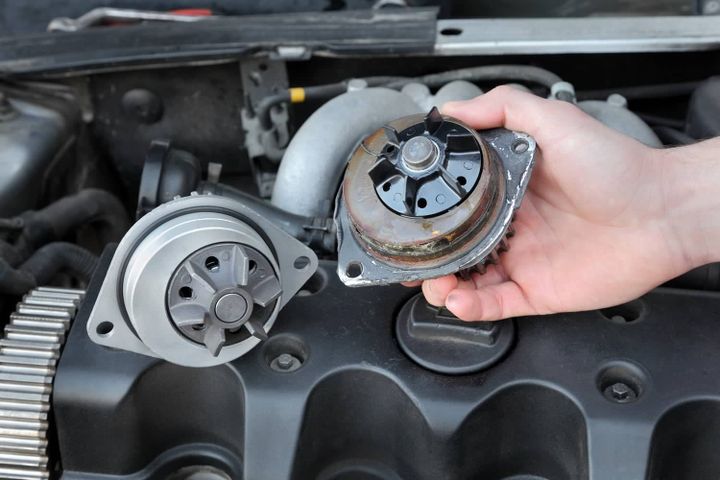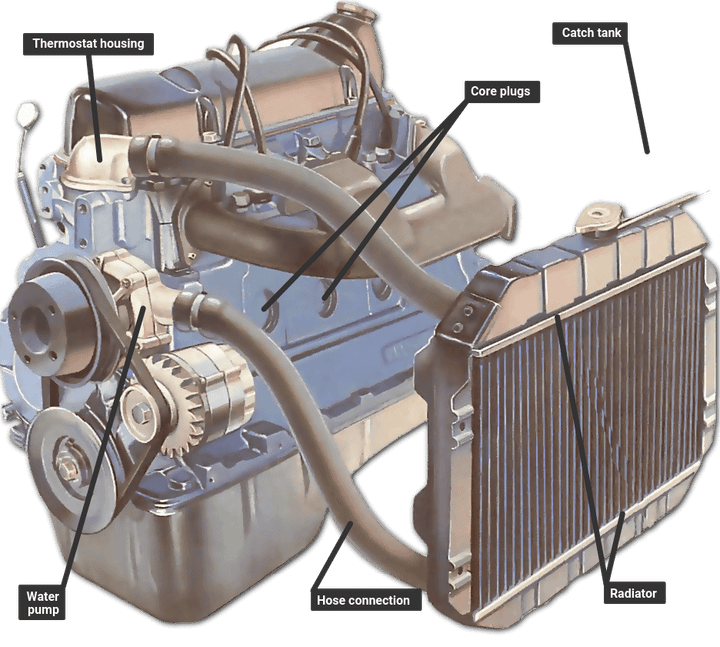


Even when the engine is turned off, your car's water pump can still leak coolant. This phenomenon might seem puzzling, but understanding the underlying reasons is crucial to identify and address potential issues before they escalate.
The water pump plays a vital role in circulating coolant through the engine to regulate its temperature. While it's common knowledge that a faulty water pump can leak coolant when the engine is running, many drivers are surprised to find coolant puddles under their car after shutting it off.
In this article, we'll explore the factors contributing to water pump leaks when the engine is off, including residual heat, lack of pressure, common leak locations, warning signs, and other contributing factors. We'll also discuss the consequences of ignoring leaks and the importance of proper maintenance.

Even after turning off the engine, residual heat remains in the cooling system, particularly in the engine block and cylinder heads. This residual heat can cause any existing cracks, holes, or failing seals in the water pump to expand or degrade further, allowing coolant to seep out.
| Residual Heat Factor | Lack of Pressure Phenomenon |
|---|---|
| Heat remains in the engine after shutdown | Cooling system operates under pressure when running |
| Hot coolant sits in the water pump | Pressure drops after engine stops |
| Existing leaks become more visible | Allows existing leaks to manifest |
When the engine is running, the cooling system operates under pressure, which helps prevent coolant from leaking out. However, when the engine stops, the pressure gradually drops, allowing any existing leaks to become more pronounced as the coolant is no longer being forced back into the system.
Water pumps can develop leaks in various locations due to wear, damage, or improper installation. Understanding these common leak points can help you identify and address potential issues before they escalate.
Shaft seal leaks: The shaft seal prevents coolant from leaking out where the pump's shaft protrudes from the housing. A worn or damaged seal can allow coolant to seep out along the shaft.
Gasket seepage: If the gasket securing the water pump to the engine block or cylinder head becomes compromised, coolant can seep out from the pump's mounting surface.
Weep hole seepage: Many water pumps have a small weep hole designed to allow controlled coolant seepage if the shaft seal fails. Excessive leakage can indicate a more significant issue.
Impeller housing cracks: Cracks or damage to the impeller housing, which contains the rotating impeller, can allow coolant to leak out, often in significant amounts.
Identifying the early warning signs of a water pump leak can help you address the issue before it leads to more severe problems or costly repairs.
Warning Signs:
Coolant puddles or drips under the vehicle
Sweet, antifreeze-like smell or steam from the engine compartment
Consistently low coolant level despite regular topping up
Frequent or unusual engine overheating
While water pump leaks can occur due to normal wear and tear, several factors can accelerate the degradation of the pump and increase the likelihood of leaks.
| Contributing Factor | Description |
|---|---|
| Pump age and mileage | Internal components subjected to increased stress and wear over time |
| Lack of maintenance | Buildup of contaminants and debris in the cooling system |
| Contaminated coolant | Wrong coolant type or improper mixture can cause corrosion and scale buildup |
| Overheating history | Excessive heat can degrade gaskets and seals more rapidly |
Ignoring a water pump leak can lead to more severe consequences and potentially costly repairs.
Continued coolant loss
Reduced heat transfer ability
Risk of engine overheating
Potential for catastrophic engine damage
Proper maintenance is crucial for extending the lifespan of your water pump and preventing costly repairs or engine damage.
Maintenance Practices:
Follow recommended service intervals for water pump replacement (typically 60,000 to 100,000 miles)
Regular coolant changes and system flushes
Inspection during routine maintenance services
Timely replacement if signs of leakage or impending failure are detected
Understanding why your car's water pump can leak coolant when the engine is turned off is essential for maintaining the health and longevity of your vehicle's cooling system and engine. By recognizing the effects of residual heat, lack of pressure, common leak locations, and contributing factors, you can identify and address potential issues promptly.
Regular maintenance, prompt repairs, and timely water pump replacements are crucial to prevent costly engine damage and ensure your vehicle's reliable performance. Stay vigilant for warning signs and address leaks promptly to avoid the inconvenience and expense of dealing with a failed water pump and potential engine overheating issues.
Water pumps can develop leaks in various locations due to wear, damage, or improper installation. Common leak points include the shaft seal, gasket, weep hole, and impeller housing cracks.
Warning signs of a water pump leak include coolant puddles or drips under the vehicle, a sweet antifreeze-like smell or steam from the engine compartment, consistently low coolant level despite topping up, and frequent or unusual engine overheating.
Factors that can contribute to water pump leaks include the pump's age and mileage, lack of maintenance, contaminated coolant, and a history of engine overheating.
Ignoring a water pump leak can lead to continued coolant loss, reduced heat transfer ability, risk of engine overheating, and potential for catastrophic engine damage.
Proper maintenance practices like following recommended service intervals for water pump replacement, regular coolant changes and system flushes, inspection during routine maintenance, and timely replacement if signs of leakage or impending failure are detected can help prevent water pump leaks.
A water pump leak becomes more noticeable after the engine is turned off because the cooling system operates under pressure when running, which helps prevent coolant from leaking out. When the engine stops, the pressure drops, allowing existing leaks to manifest more prominently.
Yes, a water pump leak can cause engine overheating if left unaddressed. Coolant loss due to the leak can reduce the cooling system's ability to transfer heat away from the engine effectively, leading to overheating.
Even after turning off the engine, residual heat remains in the cooling system, particularly in the engine block and cylinder heads. This residual heat can cause existing cracks, holes, or failing seals in the water pump to expand or degrade further, allowing coolant to seep out.
Many water pumps have a small weep hole designed to allow controlled coolant seepage if the shaft seal fails. Excessive leakage from the weep hole can indicate a more significant issue with the water pump.
It is important to address water pump leaks promptly to prevent continued coolant loss, reduced heat transfer ability, risk of engine overheating, and potential for costly engine damage. Ignoring leaks can lead to more severe consequences and expensive repairs.

Miguel started tinkering with car radios as a teenager, fascinated by the intricate dance of wires and circuits. This passion led him to pursue a career as an automotive electrician. For the past 10 years, Miguel has tackled everything from flickering headlights to mysterious electrical gremlins. He thrives on troubleshooting electrical problems and enjoys sharing his knowledge to empower car owners to understand their vehicles better.







